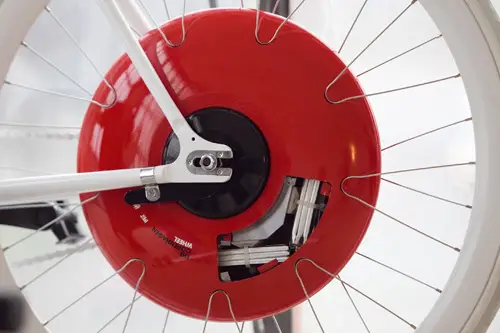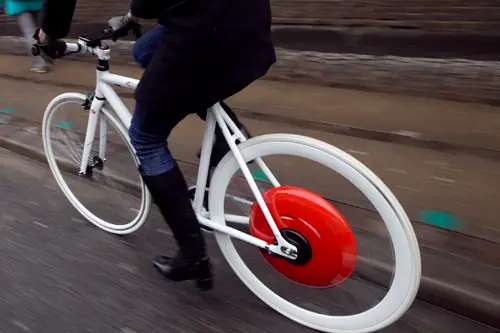To coincide with the COP 15 Climate Change Conference in Copenhagen, M.I.T. students have introduced the new Copenhagen Wheel.

The wheel has built in Bluetooth capability and a form of the Kinetic Energy Recovery System (KERS) used in F1 racing, which stores kinetic energy gained from braking for a later burst of speed.
The makers of the Copenhagen Wheel from M.I.T.’s SENSEable City Laboratory claim that the new features mark the advent of “Biking 2.0,” a new era based on smarter bikes and easier rides (and red frisbees stuck in your rear wheel).

The wheel includes sensors for detecting distance, speed, direction, all of which are beamed via Bluetooth to the rider’s iPhone. The wheel also includes a built-in lock that sends the rider a text if tampered with.
But the most notable feature of the Copenhagen Wheel is its KERS or Kinetic Energy Recovery System, a mechanism by which energy from braking is stored up for later use, giving the rider a boost when going up a hill or speeding through traffic. Some bicycle purists have already dismissed the wheel as a novelty while others suggest that M.I.T. has succeeded in reinventing the wheel.
Comments (9)
Leave Reply
Post Comment
KERS looks to be a load of tyre levers cable tied together inside a frisbee……
The most notable feature would appear to be the complete lack of performance data and the fact that it doesn’t appear to work 🙂
An exercise in futility, all that extra weight. Why doesn’t the rider get fitter instead and that would provide that extra burst of speed when needed.
I’d love KERS, if it was around 80-90% efficient.
>>An exercise in futility, all that extra weight
Things like this aren’t aimed at you and me though are they? This (or some other electric bike) will be a much more attractive proposition for a lot of people than a ‘proper’ bike.
Taking the KERS concept down to that size is very clever – regardless of whether a bunch of cyclists see the point for their pastime.
obviously MIT have got more money than the whole of F1 to get it to work as most of the teams there junked KERS for one reason or another
cypher – I’ll stick with Williams as clever people still working on it. The limits placed on the recoverable energy in F1 have been the main turn off. KERS doesn’t only have applications in F1 – it has quite a few others including public transport.
i presume (?) the main advantage of this wheel is that you can just bolt it onto any bike and it will work, theres no need to faff around with separate batteries, wires, throttle control and something to detect if you are pedalling.
i agree with mrSalmon too, these bikes are aimed at making bikes an alternative for cars for NORMAL people who aren’t obsessed with bikes and getting fit etc..